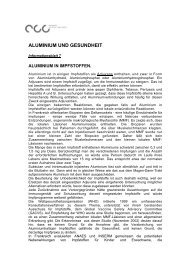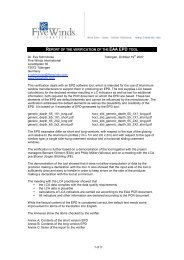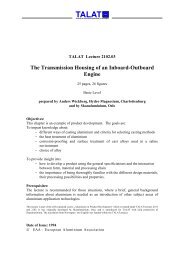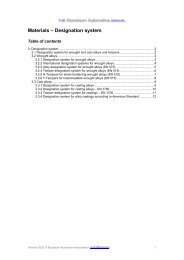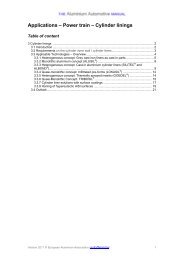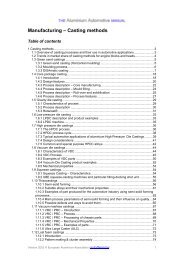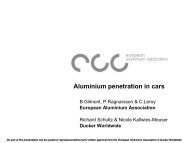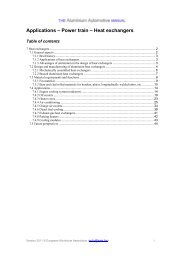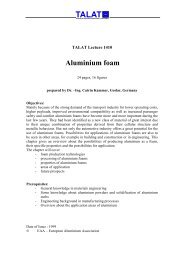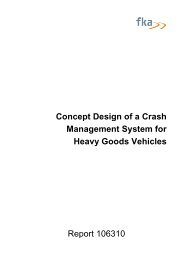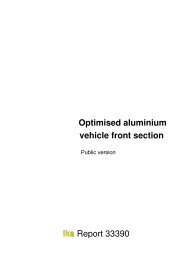aluminium in commercial vehicles - European Aluminium Association
aluminium in commercial vehicles - European Aluminium Association
aluminium in commercial vehicles - European Aluminium Association
Create successful ePaper yourself
Turn your PDF publications into a flip-book with our unique Google optimized e-Paper software.
EUROPEAN ALUMINIUM ASSOCIATION ALUMINIUM IN COMMERCIAL VEHICLES CHAPTER X 139<br />
3. Mechanical f<strong>in</strong>ish<strong>in</strong>g<br />
3.1. Brush<strong>in</strong>g<br />
Brush<strong>in</strong>g is a rather seldomly<br />
used method for the decoration<br />
of trucks and trailers. It can<br />
mostly be seen on tankers for<br />
the transport of fluid goods.<br />
Like polish<strong>in</strong>g, brush<strong>in</strong>g is based<br />
on abrasion effects between the<br />
brush surface and the <strong>alum<strong>in</strong>ium</strong><br />
surface. Due to the brush<br />
be<strong>in</strong>g the harder part, <strong>alum<strong>in</strong>ium</strong><br />
is removed from the surface<br />
by an abrasive effect. Brush<strong>in</strong>g<br />
is done with rotary brush<strong>in</strong>g<br />
tools or mach<strong>in</strong>es. Normally no<br />
additional brush<strong>in</strong>g compounds<br />
or chemicals will be used.<br />
Like for every surface treatment of<br />
<strong>alum<strong>in</strong>ium</strong>, the part to be brushed<br />
has to be cleaned and degreased<br />
properly before apply<strong>in</strong>g the<br />
brush<strong>in</strong>g process. The clean<strong>in</strong>g is<br />
done to remove any dust, dirt, oil,<br />
emulsion or other residues from<br />
the roll<strong>in</strong>g process prior to brush<strong>in</strong>g<br />
and to prevent particles from<br />
be<strong>in</strong>g squeezed <strong>in</strong>to the surface<br />
dur<strong>in</strong>g brush<strong>in</strong>g. To secure a uniform<br />
surface appearance, it is of<br />
great advantage to use an automatic<br />
process with several brushes<br />
<strong>in</strong> one s<strong>in</strong>gle station, which are<br />
simultaneously controlled.<br />
3.2. Polish<strong>in</strong>g / Buff<strong>in</strong>g<br />
Polish<strong>in</strong>g or buff<strong>in</strong>g is a quite<br />
common method <strong>in</strong> the North<br />
American market to provide a<br />
decorative surface f<strong>in</strong>ish. 3 ma<strong>in</strong><br />
methods can be applied:<br />
• Use of mirror-f<strong>in</strong>ished <strong>alum<strong>in</strong>ium</strong><br />
sheets and plates fabricated<br />
<strong>in</strong> the roll<strong>in</strong>g mill<br />
• Polish<strong>in</strong>g / buff<strong>in</strong>g of mill f<strong>in</strong>ish<br />
sheets to the desired surface<br />
appearance<br />
• Manual polish<strong>in</strong>g<br />
The use of mirror-f<strong>in</strong>ished plates<br />
or the use of already buffed or<br />
polished sheets has the advantage,<br />
that the work on site is<br />
reduced to the manual polish<strong>in</strong>g<br />
of weld seams or places which<br />
have been damaged dur<strong>in</strong>g fabrication.<br />
Great care must be<br />
taken when handl<strong>in</strong>g or work<strong>in</strong>g<br />
with these sheets, as every little<br />
trace of a mechanical defect<br />
caused by fabrication must be<br />
manually polished.<br />
Mirror f<strong>in</strong>ished plates are fabricated<br />
<strong>in</strong> the roll<strong>in</strong>g mill by the<br />
use of a special roll<strong>in</strong>g rout<strong>in</strong>e<br />
with work rolls which have nearly<br />
no surface roughness. This<br />
makes it a very demand<strong>in</strong>g<br />
process and great care must be<br />
taken to secure a reliable and<br />
constant quality of the sheets.<br />
Buff<strong>in</strong>g or polish<strong>in</strong>g of large<br />
plates is done on automatic l<strong>in</strong>es,<br />
where the surface is polished<br />
with rotary polishers across the<br />
whole width of the sheet at the<br />
same time. The rotary polishers<br />
have special pads on their surface,<br />
which polish the <strong>alum<strong>in</strong>ium</strong><br />
surface under the help of polish<strong>in</strong>g<br />
compounds. The polish<strong>in</strong>g<br />
compounds works as a slight<br />
abrasive and removes the top<br />
layer of the <strong>alum<strong>in</strong>ium</strong> surface <strong>in</strong><br />
the range of the surface roughness<br />
produced by the roll<strong>in</strong>g mill.<br />
As the result of polish<strong>in</strong>g is very<br />
much depend<strong>in</strong>g on the type of<br />
alloy and temper, the surface<br />
hardness, the type of polish<strong>in</strong>g<br />
paste and the mach<strong>in</strong>e sett<strong>in</strong>g<br />
(like rotational speed, pressure<br />
and type of pad), this is a method<br />
of “trial and error” to f<strong>in</strong>d the<br />
right sett<strong>in</strong>g per specification.



